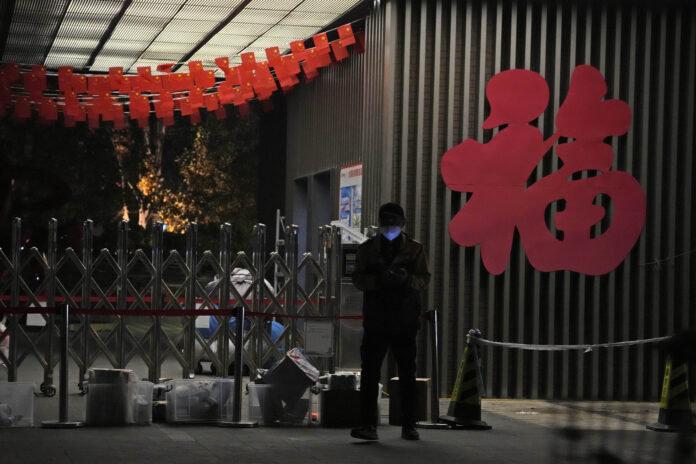Chinese cities imposed more curbs on Wednesday to rein in rising coronavirus cases, adding to investor worries about the economy, as fresh unrest at the world’s largest iPhone plant highlighted the social and industrial toll of China’s strict COVID-19 measures.
In Beijing, malls and parks were shut and once-bustling areas of the capital resembled ghost towns as authorities urged people to stay home.
The Hainan island resort city of Sanya barred people from going to restaurants and malls within three days of arrival, and numerous cities across China have imposed localised lockdowns as infections neared highs seen in April.
The measures are darkening the outlook for the world’s second-largest economy and dampening hopes that China would significantly ease its outlier COVID stance any time soon, as China faces its first winter battling the highly contagious Omicron variant.
“While there is little prospect of the authorities opting to step back from the zero-COVID policy during the winter, there is a significant risk that containment efforts fail,” analysts at Capital Economics wrote.
Such a failure could result in more lockdowns which would cause unprecedented damage to the economy, they said.
China’s COVID curbs, the tightest in the world, have fuelled widespread discontent and disrupted production at manufacturers including Taiwan’s Foxconn, Apple Inc’s biggest iPhone supplier.
1:24
Ikea shoppers in China panic, try to escape flash-COVID lockdown
On Wednesday, footage uploaded on social media showed Foxconn workers pulling down barriers and fighting with authorities in hazmat suits, chanting “give us our pay.” The unrest follows weeks of turmoil which has seen scores of employees leave the factory over COVID controls. The videos could not be immediately verified by Reuters.
Localities accounting for nearly one-fifth of China’s total GDP are under some form of lockdown or curbs, brokerage Nomura estimated earlier this week, a figure that would exceed the GDP of Britain.
Trending Now
Trending Now
Even though infection numbers are low by global standards, China has stuck with its zero-COVID approach, a signature policy of President Xi Jinping that officials argue saves lives and prevents the medical system from being overwhelmed.
China reported 28,883 new domestically transmitted cases for Tuesday.
The International Monetary Fund urged China to further recalibrate its COVID-19 strategy and boost vaccination rates.
“Although the zero-COVID strategy has become nimbler over time, the combination of more contagious COVID variants and persistent gaps in vaccinations have led to the need for more frequent lockdowns, weighing on consumption and private investment,” IMF official Gita Gopinath said.
A delivery man checks his phone after leaving his deliveries outside an old folks home decorated with the word “Fortune” in Beijing on Nov. 23.
Ng Han Guan/AP
Residents are increasingly fed up with nearly three years of restrictions, and Wednesday’s protest at the Foxconn factory in Zhengzhou comes after crowds recently crashed through barriers and clashed with hazmat-suit-clad workers in the southern city of Guangzhou.
The rising case numbers are also testing China’s resolve to avoid one-size-fits-all measures such as mass lockdowns to curb outbreaks, and rely on recently tweaked COVID rules instead.
However, unofficial lockdowns have increased, including in residential buildings and compounds in Beijing, where case numbers hit a new high on Tuesday.
In Shanghai, a city of 25 million that was locked down for two months earlier this year, China’s top auto association said on Wednesday it would cancel the second day of the China Automotive Overseas Development Summit being held there over COVID concerns.
Chengdu, with 428 cases on Tuesday, became the latest city to announce mass testing.
Major manufacturing hubs Chongqing and Guangzhou have seen persistently high infection numbers, accounting for most of China’s caseload. Cases in Guangzhou fell slightly on Tuesday to 7,970 and authorities have said infections continue to be concentrated in key areas of Haizhu district.
Investors who last week were hopeful that China would ease restrictions have grown worried that the infection wave could slow economic reopening. Many analysts say a significant easing of COVID curbs is unlikely before March or April.
A sharper than expected slowdown in China, which is hurting domestic demand in particular, would reverberate across countries including Japan, South Korea and Australia, which export hundreds of billions of dollars worth of products and commodities to the world’s second largest economy.
Analysts are also cutting forecasts for oil demand from the world’s top crude importer, with recent COVID curbs already driving global oil futures lower.
“The next few weeks could be the worst in China since the early weeks of the pandemic both for the economy and the healthcare system,” said analysts at Capital Economics.



